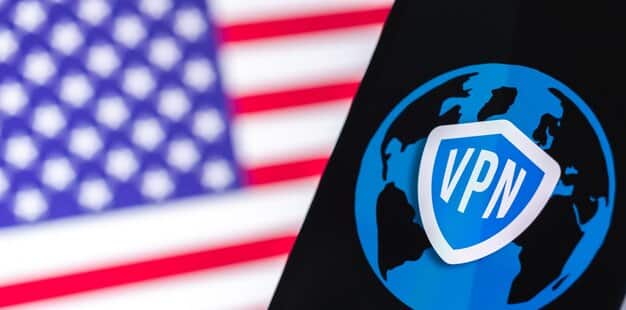Social Media Security: Protect Your Brand from Cyber Threats in the US

Social media security is crucial for US brands to protect their reputation, data, and customer trust from cyber threats such as phishing, malware, and account takeovers.
In today’s digital landscape, social media security: protecting your brand from cyber threats in the US is paramount. A single security breach can tarnish your brand’s image, compromise sensitive data, and erode customer trust. This article will explore the critical aspects of securing your social media presence, providing actionable strategies to safeguard your brand against evolving cyber threats.
Understanding the Social Media Threat Landscape in the US
Social media platforms are prime targets for cybercriminals due to their vast reach and the wealth of data they contain. Understanding the types of threats and vulnerabilities that exist is the first step in building a robust security strategy.
Common Social Media Security Threats
Several threats commonly affect businesses on social media. Being aware of these risks allows for better preparation and prevention.
- Phishing Attacks: Cybercriminals often use social media to distribute phishing links, tricking users into revealing sensitive information like passwords or credit card details.
- Malware Distribution: Social media platforms can be used to spread malware through infected links or files, potentially compromising the devices of employees and customers.
- Account Takeovers: Hackers may gain unauthorized access to your brand’s social media accounts, using them to spread misinformation, damage your reputation, or conduct fraudulent activities.
- Impersonation: Cybercriminals can create fake accounts that mimic your brand, deceiving customers and potentially engaging in scams or spreading false information.
Vulnerabilities in Social Media Platforms
Besides external threats, social media platforms themselves can have vulnerabilities that cybercriminals exploit. It’s important to stay informed about potential weaknesses.
Understanding the security settings and features available on each platform is essential. Often, simple configurations like two-factor authentication can significantly reduce the risk of account compromise.

Regularly updating passwords and monitoring platform security alerts can also help mitigate vulnerabilities. Proactive measures are key to staying ahead of potential exploits.
In conclusion, a thorough understanding of common threats and platform vulnerabilities is crucial for effective social media security. By staying informed and taking proactive measures, US brands can significantly reduce their risk exposure.
Developing a Social Media Security Policy
A comprehensive social media security policy is a cornerstone of any brand’s defense against cyber threats. This policy should outline guidelines, responsibilities, and protocols for all employees who manage or interact with the brand’s social media presence.
Key Components of a Social Media Security Policy
An effective policy should cover various aspects of social media usage and security.
The policy should emphasize the importance of using strong, unique passwords for all social media accounts. It should also mandate regular password updates and discourage the sharing of passwords among employees.
- Password Management: Require strong, unique passwords and regular updates. Discourage password sharing.
- Employee Training: Conduct regular training sessions to educate employees about social media threats and best practices for security.
- Account Access Control: Implement strict access controls, limiting the number of employees with administrative privileges and regularly reviewing access permissions.
Enforcement and Review
A policy is only effective if it’s consistently enforced and regularly reviewed.
Regular audits of social media accounts and employee activities can help identify potential security gaps or violations of the policy. Clearly defined consequences for policy violations are also essential to ensure compliance.

The policy should be reviewed and updated periodically to reflect changes in the threat landscape and platform features. Staying up-to-date with the latest security trends is crucial for maintaining an effective defense.
In summary, a well-defined, consistently enforced, and regularly reviewed social media security policy is essential for protecting your brand from cyber threats. It sets clear expectations for employees and provides a framework for maintaining a secure social media presence.
Implementing Two-Factor Authentication (2FA)
Two-factor authentication (2FA) adds an extra layer of security to your social media accounts, making it significantly more difficult for cybercriminals to gain unauthorized access. By requiring a second verification method in addition to your password, 2FA can protect your accounts even if your password is compromised.
How 2FA Works
2FA typically involves verifying your identity through a code sent to your mobile device or generated by an authenticator app. This means that even if a hacker knows your password, they won’t be able to access your account without also having access to your second authentication factor.
Enabling 2FA on all social media accounts is a simple and effective way to significantly reduce the risk of account takeovers. Most platforms offer 2FA options in their security settings.
Choosing the Right 2FA Method
While SMS-based 2FA is a common option, authenticator apps are generally considered more secure. SMS messages can be intercepted, while authenticator apps generate unique codes offline.
- Authenticator Apps: Use apps like Google Authenticator or Authy for more secure code generation.
- Backup Codes: Store backup codes in a safe place in case you lose access to your primary 2FA method.
- Hardware Security Keys: Consider using hardware security keys for even stronger protection.
It’s important to carefully consider your risk tolerance and the sensitivity of the data stored in your social media accounts when choosing a 2FA method.
In conclusion, implementing 2FA is a crucial step in securing your social media accounts from unauthorized access. It adds an extra layer of protection that can significantly reduce the risk of account takeovers and data breaches.
Monitoring Social Media for Suspicious Activity
Proactive monitoring of your social media accounts can help you identify and respond to potential security threats quickly. By tracking activity, you can detect suspicious behavior, such as unauthorized logins, spam posts, or impersonation attempts.
Tools for Monitoring Social Media Activity
Several tools and techniques can help you monitor your social media accounts for suspicious activity.
Many social media platforms offer built-in analytics tools that allow you to track login locations, device types, and other account activity. These tools can help you identify unusual patterns that may indicate a security breach.
- Platform Analytics: Utilize built-in analytics to track login locations and device types.
- Social Listening Tools: Employ social listening tools to monitor brand mentions and identify potential impersonation attempts.
- Security Alerts: Enable security alerts to receive notifications about suspicious activity.
Responding to Suspicious Activity
When you detect suspicious activity, it’s important to take immediate action to mitigate the risk.
Immediately change your password and revoke access for any unauthorized devices. Report the suspicious activity to the social media platform and consider alerting your customers if their data may have been compromised.
In summary, proactive monitoring of your social media accounts is essential for detecting and responding to potential security threats. By utilizing available tools and taking prompt action, you can minimize the damage caused by cyberattacks.
Training Employees on Social Media Security Best Practices
Your employees are often the first line of defense against social media security threats. By providing comprehensive training on best practices, you can empower them to identify and avoid potential risks.
Key Training Topics
Effective training programs should cover a range of topics related to social media security.
Employees should be trained to recognize phishing attempts, avoid clicking on suspicious links, and protect their passwords. They should also be aware of the potential risks of oversharing personal information on social media.
- Phishing Awareness: Teach employees to recognize and avoid phishing attempts.
- Password Security: Emphasize the importance of strong, unique passwords.
- Data Privacy: Educate employees about the risks of oversharing personal information.
Regular Updates and Reinforcement
Social media threats are constantly evolving, so it’s important to provide regular updates and reinforcement of training materials.
Consider conducting periodic refresher courses or sending out regular security tips to keep employees informed about the latest threats and best practices. Gamification can also be an effective way to engage employees in security training.
In conclusion, comprehensive and ongoing training is crucial for empowering employees to protect your brand from social media security threats. By investing in employee education, you can significantly reduce the risk of human error and security breaches.
Staying Up-to-Date with Social Media Security Trends
The social media security landscape is constantly evolving, so it’s important to stay informed about the latest trends and threats. By staying up-to-date, you can proactively adapt your security measures and protect your brand from emerging risks.
Sources of Information
Several resources can help you stay informed about social media security trends.
Follow security blogs, industry publications, and social media security experts on social media. Attend webinars and conferences to learn about the latest threats and best practices.
- Security Blogs: Follow reputable security blogs for the latest threat intelligence.
- Industry Publications: Read industry publications for insights into social media security trends.
- Security Experts: Follow social media security experts on social media for real-time updates.
Adapting Your Security Strategy
As new threats emerge, it’s important to adapt your social media security strategy accordingly.
Regularly review your security policies, update your software, and implement new security measures as needed. Staying agile and responsive to changes in the threat landscape is crucial for maintaining a strong defense.
| Key Aspect | Brief Description |
|---|---|
| 🛡️ Threat Awareness | Understanding common social media threats. |
| 🔒 Security Policy | Developing a clear social media security policy. |
| 🔑 Two-Factor Authentication | Implementing 2FA for enhanced account security. |
| 🧑💻 Employee Training | Training employees on security best practices. |
FAQ
▼
Social media security protects your brand’s reputation, customer trust, and sensitive data from cyber threats. A breach can lead to financial loss and a damaged image.
▼
Common threats include phishing attacks, malware distribution, account takeovers, and impersonation attempts. These can compromise your brand’s social media presence and data.
▼
2FA requires a second verification method, like a code sent to your phone, making it harder for hackers to access your accounts even if they know your password.
▼
It should include guidelines for password management, employee training, access control, and regular policy reviews to adapt to evolving threats and platform changes.
▼
Use platform analytics, social listening tools, and security alerts to track login locations, brand mentions, and potential impersonation attempts. React swiftly to identified threats.
Conclusion
Protecting your brand from cyber threats on social media requires a proactive and comprehensive approach. By understanding the threat landscape, implementing robust security policies, and staying up-to-date with the latest trends, you can safeguard your brand’s reputation, data, and customer trust in the US market.





